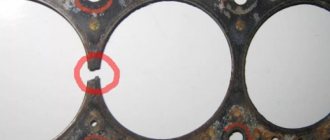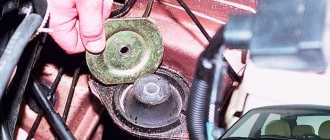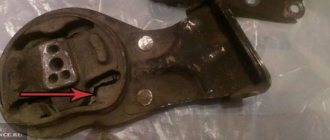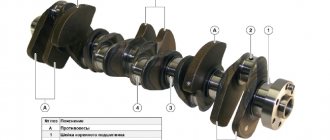Engine mount: what it affects and how it works
On various domestic and foreign cars until the 80s, the engine mount was actually a thick rubber that was screwed to the engine and body. This solution was widely used on cars, which at that time were overwhelmingly rear-wheel drive. At the same time, simple supports coped well with their tasks.
However, later the bodies became lighter, the thickness of the steel decreased, the requirements for passive safety changed, etc. As a result, pillows evolved into more complex products made of metal and rubber. Elite car models now have hydraulic engine mounts that can provide maximum comfort compared to other analogues.
So, the engine of a modern passenger car with front-wheel drive is often mounted on 4 or 5 supports. As a rule, two airbags are located at the gearbox, the rest are attached to the power unit. The engine itself and the gearbox have a rigid connection.
As for the internal combustion engine, it is customary to highlight the right airbag, as well as the front and rear. The right engine mount is attached to the front right side member. This support is located on top. The front engine mount is often attached to the front beam, located below. The rear cushion is also located at the bottom and can be attached to the underbody or to the subframe. By the way, on many models the rear support is structurally absent.
If we talk about the design, rubber-metal engine mounts may differ in shape and materials of manufacture, but often they are based on a metal cylinder into which a silent block is pressed.
The main task is to securely, but not rigidly, fix the internal combustion engine, while the cushion simultaneously absorbs vibrations and dampens the resulting vibrations. As a result, vehicle controllability improves, the engine itself is less vibration-loaded, attachments suffer less from vibrations, vibrations are not strongly transmitted to the car body, etc.
Features of mounts for different engines
Depending on the car and its technological features, the power plant can have from three to five airbags.
The function of the supports is to dampen vibration at idle speed, as well as when the engine reaches its maximum load level. On VAZ 2110 cars, as a rule, rubber-metal cushions are installed. Moreover, their number directly depends on the number of valves: for 8-valve models there are 3 airbags (two on the sides and one in the rear), and for 16-valve “ten” valves there are 4 (two on the sides and 2 in the front: top and bottom).
In electric vehicles, the electric motor mounts consist of three budget mounts - left, right and center. On all electric vehicles their number is the same.
On KamAZ vehicles, the engine is mounted on four supports: two at the front and two at the rear. The front supports consist of 2 brackets and a rubber cushion. One bracket is attached to the block cover, and the second to the frame spar. The brackets of the left and right supports are connected with a tie.
On Renault Logan engines, the mounts look like a guitar, made of rubber with metal inserts. There are three pillows in Logans - on the sides and bottom. Moreover, the bottom one is not so easy to detect, so it is often confused with other parts. To see it, you need to lift the car or go down into the inspection hole.
On the VAZ 2170 Priora, as well as on other representatives of the Volzhsky Automobile Plant, with internal combustion engines equipped with 16 valves, 4 rubber cushions are installed. The front and rear are mounted through brackets on the crankcase and engine. They transfer the weight of the power plant to the body and limit its longitudinal movements. The left and right pillows are installed with rods that limit the transverse movements of the motor.
Features of engine mounts
The most widely used today are universal-use rubber-metal supports, which operate on the principle of silent blocks in the suspension. The presence of an elastic element makes it possible to provide a damper during torsion and vibration, and metal elements guarantee the strength and durability of such supports.
Some cars are equipped with adjustable hydraulic cushions that use the principle of shock absorbers. They have a special working fluid inside, which flows from chamber to chamber, thereby preventing the occurrence of vibration. The disadvantage of such hydraulic supports is their high cost.
Engine hydraulic mount: how is it designed, how to diagnose it and can it be repaired?
It is a rare modern engine that does not rest on hydraulic cushions under the hood in order to minimally disturb the driver and passengers with its vibrations. What are the benefits of such supports, when did they appear in the automotive industry, how will they evolve and... when will they disappear?
The fact that the oscillating parts of the mechanism need to be vibration-isolated from the stationary ones was clear to the ancient Romans, who already in the first century BC figured out how to hang the “body” of the cart from a chassis with wheels on belts made of thick shock-absorbing leather. In the automotive industry, rubber dampers for installing an engine on a chassis were introduced by Walter Chrysler in the late 1920s, initially for Plymouth models. Vibration isolation was a good competitive advantage, so technology even came up with the marketing name Floating power. In Europe, the pioneer in the introduction of rubber dampers was Citroen, which bought the rights to the technology from Chrysler to implement it in the Traction Avant design.
For many decades, the rubber engine mount remained one of the most conservative parts of any car, and its evolutions were extremely subtle. And today there are still quite a few cars driving on the roads (UAZs, Volgas, Moskvichs), whose engine support cushions are the simplest monolithic rubber block or disk.
In principle, to prevent engine vibrations from destroying the steel frame of the body and causing chronic seasickness in the driver, these primitive rubber “chocks” are quite sufficient. However, the growing requirements for comfort inside the car gave rise to some of their development - engineers played with the shape of dampers, made sandwiches from rubber of different elasticity, and included steel springs in the structure. This bore fruit - the supports began to work in a wider range of vibrations and loads: at loads of different strength and direction, different elements of the rubber modules were included in the work, providing, when necessary, increased elasticity or, conversely, increased rigidity:
However, in the mid-80s of the twentieth century, European automakers began to introduce rubber-hydraulic engine mounts into their models. Thus, one of the first cars to use hydraulic support was the Mercedes-Benz W124. Unlike purely rubber ones, they damped vibrations in a wider range of frequencies and amplitudes, acting on the principle of a shock absorber - damping vibrations due to the resistance of the liquid forced through calibrated throttling holes.
Rubber-hydraulic mounts did not cause any revolution in the automotive industry - by the time of their appearance, engineers had long ago learned how to properly calculate ordinary rubber mounts for specific engines with their peculiarities of vibration distribution, and they worked very effectively. But designs with hydraulics were somewhat more precisely tuned to the characteristics of the engine than purely rubber ones. They began to install one rubber-hydraulic mount on the engine (less often two), redistributing the loads on it so as to improve damping and extend the life of adjacent mounts with a conventional structure, made of simple rubber.
Device and diagnostics
The design of the hydraulic part of the engine mount is simple. Inside it, under the main load-bearing rubber stop (like a support without hydraulics), there are two compartment chambers located one above the other, filled with liquid. The chambers are separated by a rubber damping wall-membrane, but they also communicate with each other through a small hole - a throttling flow. At small vibration amplitudes the membrane resists the vibrations, at large amplitudes the flow channel comes into operation. In essence, such a support has two “sub-ranges” in which it exhibits different damping characteristics.
Despite the fact that the liquid in a failed support is usually black with rubber dust, the hydraulic part of the support rarely suffers from physical wear - as a rule, the rubber block is the first to give out, losing elasticity with age due to partial detachments from the metal, micro-tears and cracks.
It is important to understand that the liquid and, in general, the entire hydraulic part in the rubber-hydraulic support does not play a leading role, but an auxiliary one. The mass of the engine, as is the case with conventional rubber mounts, is supported by a powerful elastic rubber element. And if for some reason the liquid leaves the support (which sometimes happens due to a break in the elastic bottom or due to a leak in the rolling of parts of the body), then a catastrophe will not occur - except that the level of vibrations in the body will increase. And it’s not a fact that even throughout the entire speed range - the defect is usually more noticeable at idle.
However, it is still not worth delaying the replacement of the support - the increased amplitude of the engine’s swing causes it, when starting or gaining speed under load, to hit the stationary elements of the engine compartment, which can damage various pipes, hoses, and wires. And the rest, usually still quite alive, the supports begin to wear out intensively after the death of the leading, hydraulic one.
If you take the support by the working part (the one to which the bracket connecting it to the engine is screwed) and swing it (by the support in its pure form or by the engine itself), then you will not feel its “hydraulic essence” in any way - only ordinary rubber elasticity. Therefore, visually, faults in the rubber-hydraulic cushion are usually impossible to detect. Well, with the exception of cases where liquid is openly leaking from it... Both the new support and the dead one respond with a certain elasticity to a manually applied force - without experience or at least comparison with a similar machine with a known good support, finding the problem alone is difficult for a non-specialist, although an experienced mechanic can do it it's easy.
Therefore, to diagnose the serviceability of the airbag in garage conditions, it is necessary to observe the behavior of the support in conditions close to working conditions, when the assistant accelerates under load (turning on the “D” mode or slightly releasing the clutch on the handbrake). The amplitude of the engine swing and the possible contact of the central axial fastener with the support of its holder (body) is controlled, which is unacceptable:
Repair of rubber-hydraulic bearings is not practiced. They are non-separable and there are no spare parts for them on sale. Although there is a garage practice of replacing supports with similar ones (we will not use the term “similar”) from other models and even brands of cars. The fastenings at the supports are redone - holes are re-drilled, adapter plates are made, etc.
When to check engine mounts
How do you even understand that you need engine mount diagnostics? Signs of malfunction of this part are as follows:
Damaged engine mount
- vibration, possibly strong, that you feel on the steering wheel or body of the car;
- knocking noises from the engine compartment that can be heard even at idle;
- transmission jolts while driving (especially with automatic transmissions);
- impacts under the hood when driving over uneven surfaces;
- increasing vibrations, shocks, knocking when starting and braking.
Therefore, if your car “kicks”, “shakes”, “knocks”, especially when changing engine modes, shifting the gearbox, starting from a stop and braking to a stop, then the problem is probably in the engine mount.
It is not always the pillow that will cause the problems described above. Vibrations, jolts and knocking can be caused by problems with injectors,
gearbox
and basic violations of crankcase protection fastenings or exhaust system parts. But in any case, checking the engine mounts is the simplest operation that can be performed. You will either identify the cause of the problem through a visual inspection, or you will realize that you need to move on to checking other options.
What can happen if faulty supports are not replaced?
What happens if you do not pay attention to possible malfunctions of the engine mounts? At first, when vibration and knocking are unnoticeable, nothing critical will happen. But with the destruction of the engine mounts, the power unit will begin to transmit vibrations to chassis parts and they will begin to fail much faster; this could have happened under the same operating conditions. Also, the engine can hit elements of the engine compartment and lead to damage to various pipes, hoses, wires and other parts. And the condition of the engine itself may suffer due to constant impacts that are not dampened by anything.
How to extend the life of engine mounts
Engine mounts work hardest when the engine vibrates the most. This is primarily starting from a stop, accelerating and braking. Accordingly, a driving mode with a soft start and less sudden acceleration and stopping prolongs the life of the engine mounts.
Of course, these parts last longer on good roads, but this factor is very difficult for us to influence. As well as for launches in sub-zero temperatures, when the rubber hardens and tolerates vibrations less well. But in general, we can say that a careful and quiet ride can extend the life of many parts, including engine mounts.
Source
Causes of problems
Most often, special rubber bands on engine mounts wear out, becoming tanned or losing their elasticity. The metal elements of the airbags themselves can also break, which is typical for operating a car on not very high-quality Russian roads. It has been noted that engine mounts wear out faster in those drivers who practice an aggressive driving style. The fact is that during sharp braking, increased loads are placed on the engine mount, which leads to their rapid failure.
Torn engine mount: signs
Like any other part, the power plant support also has a limited service life and eventually fails. On average, airbags on modern cars are designed to last at least 100-120 thousand km, although in practice these elements may need to be replaced both earlier and much later than this period.
Usually the cause of problems is the rubber insert, which simply cracks and breaks under load. Less often, cracks appear in the metal part of the support, the installation sites of fasteners are broken, etc.
One way or another, the following symptoms usually indicate a malfunction of the engine mounts:
- The engine itself runs smoothly, but the driver feels a clear increase in vibrations in the body, on the steering wheel, on the gearshift knob, etc.;
- When you start moving from a standstill, as well as during braking, you can hear clicking or muffled knocking in the engine compartment;
- When driving on an uneven road, impacts are heard from the front of the car; in many cases such impacts are felt on the gearshift lever; shifting gears with a manual transmission at this moment can be difficult;
To check the engine mounts, it is not necessary to immediately go to a service station and drive the car to a stand. Usually, a fault can be identified and localized on your own, even if you do not have much experience in car repair and maintenance.
The simplest method of initial diagnosis is to rock the engine with your hands in the engine compartment, after which you can localize a torn or cracked support by knocking.
Another technique for diagnosing engine mounts is when the hood is first opened and fixed, then the car is started and jerked forward in first gear. The car moves backwards in the same way. At this time, an assistant outside monitors the vibrations of the internal combustion engine.
To carry out a more detailed check, you first need to find out in advance where exactly the supports are located on a particular model. Then the elements available for review will need to be pre-inspected. Cracks, breaks and other damage are usually visible and easily visible.
For a full visual assessment of the lower airbags, you need to be prepared for the fact that the car will need to be parked in a garage with an inspection hole, driven onto an overpass, or using a lift.
We also recommend reading the article about
how to replace engine mount
. From this article you will learn how to replace an engine mount, as well as what subtleties and nuances should be taken into account as part of this procedure.
If a superficial diagnosis shows nothing, then the assistant should be used again. One person uses a pry bar to move the support, while the other watches for tears in the rubber insert at the very moment the support moves. It happens that some cracks are not immediately visible without rocking.
After detecting a torn engine mount, the damaged element should be replaced. It is not recommended to try to press the rubber insert out of the cylinder in order to save on spare parts, since such makeshift repairs often do not bring the desired results.
As for the replacement itself, replacing the top cushion is quite simple. The car needs to be jacked up, the old cushion removed and a new one installed. If you have to change the lower supports, it is also important to consider that the engine goes down after removing this cushion. This means that you will need an additional support that supports the internal combustion engine, allowing you to direct the cushion and properly secure this element.
Self-replacement
If a visual inspection reveals problems in the pillow, it should be replaced as soon as possible. Start by purchasing a new part. It should be noted that it is better not to buy this spare part for disassembly, even if it is in good condition. In this case, saving money can do more harm than good. Ideally, it would be to buy an original part.
- Remove the terminals from the battery. Raise the car to a height that will allow access to the engine from below. In this case, you can use a jack and wooden blocks as support.
- Raise the engine with a jack to free it from loading the desired part.
- Remove the bolts that secure the cushion to the engine and body.
- Place the new part in place, guiding it properly into place. Tighten the mounting bolts well. It's best to tighten them while the engine is running to avoid excessive vibration in the future.
- Once you have finished installing the cushion, put all the dismantled parts back in place.
In each individual case, it may be that there is no convenient access to replace the part. In this case, try to remove those components that prevent you from making a replacement.
Sometimes this operation may require another person to help guide the motor while you push the part into place. If we are talking about the top cushion, then, as a rule, it will not be difficult to inspect it and, if necessary, replace it. It will be possible to do without a hole.
Periodically check the condition of the engine mounts on your car. As you can see, this is not at all difficult, but it can help prevent many problems in the future and ensure you have a comfortable ride in any conditions. Remember that a car feels when it is being looked at and then thanks its owner for a long and good service.
Signs of wear on the cushions
The main sign of wear on the cushions is strong vibration, which is transmitted from the engine to the body. It is especially noticeable during acceleration, as well as while the engine is idling. If wear is severe, there may also be some wobble in the gear lever, indicating significant wear on the engine and transmission mounts.
At low speeds, especially when driving downhill, a characteristic metallic sound may be heard from under the hood, which differs from the sounds from the suspension. This is the sound of an engine rocking on worn mounts, and the energy of the engine is such that it may seem that there is a heavy suspended foreign object under the hood.
If you open the hood and inspect the engine, it may seem that the engine seems to have fallen to one side. This is explained by the fact that the engine mounts on one side are worn out more than on the other side, and the engine loses its original mounting geometry.
Check procedure
Pillow inspection
- Drive the car with the previously dismantled protection into the garage or onto an area with a flat floor covering.
- Raise the car by placing a jack under one of the front (or, if you have a rear engine, the rear) wheels.
- Place the existing support under the engine so as to remove the load from the engine mount. After making sure the support is secure, lower the jack.
- Using a tackle or something else, get under the car and begin inspecting the condition of the engine mounts.
Visually you will be able to detect:
- cracks and tears in rubber;
- that the gum has become stiff;
- pillow delamination.
Damaged engine mounts
However, it may turn out that visually you have not identified any of the possible problems. In this case, you can test the attachment points of the engine mounts to the body or front beam of the car for play. To do this, just tilt the engine in different directions, using a stick/pry bar as a lever. If no play is detected, then rest assured: the engine mounts are in order.
If there is play, and especially if it is noticeable (the engine moves noticeably from side to side), then it will be necessary to get rid of it. To do this, you will need to reinstall the jack and raise the car, then remove the safety support from under the engine. Check that the engine mount is securely tightened. If not, tighten it using a wrench or ratchet.
How to check the engine mount
There are several basic methods for checking engine mounts. Two are universal and are used both for diagnosing traditional rubber-metal ICE mounts and hydraulic mounts. If you have a Toyota, Ford or another foreign car that has hydraulic mounts installed, then checking the functionality of the engine mounts can be done using other methods, including even using a smartphone. Let's look at them all in detail.
Checking rubber-metal engine mounts
The first method , which will help determine the malfunction, is the simplest, but the least informative. Open the hood, ask the assistant to start the engine, and then slowly move away, driving literally 10 centimeters, then turn on the reverse gear and move back. If the engine changes its position as a result of changing vehicle driving modes, or it vibrates too much, most likely the problem is in the airbags. This method is best suited for checking the right, or upper, engine mount - it is clearly visible under the hood. However, several airbags or a problem with the lower support may fail at once, so it’s worth moving on to the next option.
The second method will help make sure that the integrity has been damaged and check the condition of all the pillows . It will require a pit or overpass, a jack, a support or prop, a pry bar or a strong lever. Then follow the algorithm.
- Raise the front of the car with a jack (if you have a rear engine, then the rear).
- Secure the raised vehicle with jack stands or a support/block.
- Use the released jack to support the engine and remove its weight from the mounts.
- Inspect the engine mounts for damage.
Checking the hydraulic cushion with the engine running
Visual inspection of the rubber-metal support
What can you see when examining them? Traces of destruction or damage to the structure, ruptures, cracks, delamination of the rubber layer, detachment of rubber from the metal part. During the inspection, special attention should be paid to the junction of rubber and metal.
Any noticeable damage to the airbag indicates its failure. This part cannot be repaired or refurbished. If it is faulty, it only needs to be replaced.
If the visual inspection does not produce results, then another procedure must be performed. Have a helper take a pry bar or lever and move the engine slightly in the area of each mount. If there is noticeable play at the mounting location, you just need to tighten the support fastenings more tightly. Or by doing this you will be able to detect the separation of the rubber support from its metal part.
Method for determining the source of vibration
If the inspection does not help and the vibrations continue, you can use the method described in this video. In order to accurately determine the origin of vibration, because it can come not only from the engine, but also from the gearbox, exhaust pipe, or contact of the protection to the crankcase, service station specialists use a jack with a rubber pad. The device will replace the support, taking the entire load upon itself. By alternately hanging the motor at points close to the original supports, they determine where the vibration disappears during such manipulations.
How to check engine mounts on a VAZ
If we talk about the most popular VAZ cars, for example model 2170 (Priora), then all the cushions in it are ordinary, rubber-metal. Even modern Lada Vestas do not use hydraulic mounts. Therefore, for “vases”, only the external inspection of the airbags described above is relevant, although only in the case of installing standard supports, and not modernized ones, since there are alternative options from third-party manufacturers, or airbags that are suitable from other cars. For example, on Vesta, as a replacement for the original right airbag (article 8450030109), they use a hydraulic support from a BMW 3 in an E46 body (article 2495601).
Characteristic signs of “dead” VAZ engine mounts are:
- too strong and sudden jerks of the engine;
- The steering wheel jerks at high speeds;
- It knocks out gears while driving.
How to check the right, rear, front, left engine mounts
Depending on the design of the car, the airbags in it can be installed in different places. For example, in VAZ 2110-2112 cars, the upper support (known as the “guitar”), the right side and left side, as well as rear airbags are used. Most Mazda cars have right, left and rear supports. Many other cars (for example, Renault) have - right, front and rear.
Most often, it is the right airbag that is installed in the upper part of the car, which is why it can also be called the upper one. Therefore, the first test method, without a hole, is best suited for the right (upper) support. The second method is for the front and rear mounts that secure the engine underneath.
Please also note the peculiarity that in different car models, not all pillows may be of the same type. It often happens that the supports in the upper part are hydraulic, and in the lower part - rubber-metal. In expensive cars, all the supports are hydraulic (they can also be called gel). You can check them using methods that will be described below.
How to check engine mounts video
Checking and replacing the right Logan engine mount
Checking and replacing engine supports on VAZ 2113, 2114, 2115
Checking the engine hydraulic mount
The method of rocking and vibrating the engine during startup is also relevant for checking hydraulic (gel) cushions, but it is also worth inspecting their body for the presence of hydraulic fluid leaks. You need to look both at the top of the support, where there are technological holes, and at the bottom, where it can wear out. This applies to any hydraulic cushions - both mechanically controlled and electronic-vacuum.
Failed hydraulic cushions are much easier to identify than regular ones. It’s impossible not to notice engine shaking, knocking, vibration in the body during startup, driving over bumps and passing speed bumps, or kickback to the gearshift knob. It is also easier to identify play in the vertical and horizontal directions when loosening a jacked engine with a pry bar.
The simplest method by which you can check the serviceability of the upper right hydraulic cushion is to place the car on the handbrake and apply the gas strongly. Any driver can notice engine deviations and rod stroke in the support.
Checking the hydraulic engine mounts
The following method is suitable for cars with hydraulic engine mounts on cars with automatic transmission. You will need a smartphone with a vibration measurement program installed (for example, Accelerometer Analyzer or Mvibe). First, turn on drive mode. Then look on the screen to see if the vibration level has increased. Then do the same in reverse gear. Determine in which mode the engine vibrates more than usual. Then ask an assistant to take the wheel while you look at the engine. Let him turn on the mode in which the vibrations intensified. Pay attention to which side the motor sags at this moment - it is this cushion that is damaged.
Another test method is suitable for vehicles with exclusively hydraulic mounts that use electronic vacuum control of the mounts. To do this, you need to start the engine, and it is better to open the oil filler cap, so the engine knocks can be heard more clearly. Then you need to find the vacuum hoses that go to each of the pillows. The right one is usually accessible from above by simply opening the hood (as in this video). We remove the airbag hose, clamp it with a finger - if the knocking disappears, then there is a gap in the airbag and there is depressurization, so it knocks.
How to change supports
To replace, you will need to purchase front, left and rear airbags. Experts advise replacing the entire set during repairs, since after replacing one part, another one may break after a while. The average cost of parts is 2000 rubles. If you have the necessary tools, you can do the repair yourself and save on car service.
List of tools
To replace the pillows we will need:
- 2 good jacks;
- metalworking tools;
- scrap;
- steel rope;
- glue.
Tip: At some stages you will need to lift a lot of weight, so it would be a good idea to invite a neighbor or a fellow car enthusiast here.
Replacing the front airbag
The repair of each support has its own characteristics. Replacing the front airbag is carried out as follows:
- Put the car in 1st gear or the handbrake so that it does not move.
- To gain access to the support, remove the upper engine protection.
- Raise the engine with a jack. To avoid damaging its lower part or other elements, place a wooden board underneath.
- When we have freed the support from the load, we can unscrew the bolt that connects it to the bracket.
- We unscrew the bolts connecting the pillow to the motor.
Removing the bolt that secures the cushion to the engine - We remove the old part and install the new one.
Tips and tricks
It is important to understand that the airbags experience the heaviest loads when the car suddenly starts from a standstill, as well as during heavy braking. The service life of the supports is also reduced by driving through potholes when the body and engine sway, especially at high speed.
As for diagnostics and repairs, it is necessary to check and change engine mounts in a timely manner, since increased vibrations not only affect comfort, but also have an extremely negative impact on the engine itself, the body and the equipment. In other words, even if one airbag is torn, it is strongly not recommended to further operate the car with such a malfunction.
Useful tips
When installing new supports, apply a light coat of thread sealant to the threads. This will prevent unauthorized loosening of the bolts during operation and protect the threads from dirt and corrosion. It is recommended to replace the supports as a set so as not to make repeated repairs in the near future. Keep an eye on the tightening torque. On VAZ cars of the “tenth” family, the front and right support is tightened with a force of 54-70 Nm. Additional rear – 90-120 Nm. At this point, the procedure for replacing the pillows can be considered completed and you can begin daily use.
Diagnostics of the condition of engine mountings
Self-diagnosis of the condition of the engine mounts is not particularly difficult; you just need to open the hood and try to move the engine manually or using a lever. If it is noticeable that the engine sags or begins to fall on one side, then this indicates damage to the cushions that will need to be replaced.
If there are such malfunctions, the power unit is raised on special suspensions, the cushions are replaced with new ones, and then the engine and gearbox are fixed. It is difficult to carry out such repairs on your own, since you need to have appropriate lifts that can be used to fix and lift the engine in order to change worn out cushions.
As a preventative measure, you should maintain the suspension in good technical condition and prevent oil or antifreeze from coming into contact with the rubberized supports. In this case, such pillows will serve you for as long as possible, and the car owner will not need to go to a service center every 100 thousand kilometers and perform expensive engine repairs.
Let's sum it up
During the operation of the vehicle, wear may occur on the engine mounts, as a result of which vibration from the engine is transmitted to the body, which in turn significantly worsens the comfort of driving the vehicle. If such vibration or extraneous knocking of the engine appears, the engine seems to be visually overwhelmed and shifted to one side, then in such a case it is necessary to contact a service center and carry out competent car repairs.
Significant wear of the engine mounts leads to severe engine tremors; the engine may sag in the engine compartment, requiring immediate repair and restoration of the vehicle.
Diagnostic methods
Signs of wear on engine mounts
- Engine vibration at idle.
- Extraneous knocks while driving, felt in the engine compartment or under the gearbox.
- Jerks during dynamic acceleration of the car.
- Knocks in the engine compartment when starting or stopping the engine.
- Difficulty shifting gears.
On cars with hydraulic supports, in addition, acceleration dynamics may deteriorate. Visually, faulty airbags can be identified by delamination and ruptures of rubber dampers or breakage of aluminum brackets. An experienced specialist can also visually identify a sagging pillow by how severely its damper is deformed.
Types of pillows
Despite the variety of design options, the general purpose of the cushions is to act as an engine mount, i.e. dampen vibrations and vibrations of the power unit. The role of an engine damper is usually played by rubber (sometimes in interaction with the hydraulic properties of the oil), absorbing shocks and vibration, while preventing displacement of the power unit.
As an example, we can take the motor mount on the Niva. It is a rubber cylinder with plates with threaded rods welded to it. The left and right engine mounts are absolutely identical, the third, which supports the gearbox, has a slightly different appearance and is mounted on a crossbar mounted on the bottom of the car.
The dimensions of the supports and their attachment points are designed in such a way as to prevent displacement of the power unit, while the weight of the engine compresses the cushion, and is distributed in such a way that rupture of the rubber due to its shear deformation is practically eliminated. In a similar way, the engine, also located longitudinally to the axis of the car, was installed on " Volgakh".
But with a transverse engine arrangement, it is somewhat more difficult to balance it, due to the design of the power unit as a whole. Therefore, the supports most often take the form of suspension arms, which have silent blocks as an engine damper, as on the additional supports of the VAZ 2112: This design of supports is also sometimes caused by the need to support the points of the engines most distant from the body, which after modernization have acquired a large mass.
The use of additional supports allows you to install heavier engines without significant changes to the design of the car. The most typical method for relatively small power units is the method of “hanging” them, as on 2108 -09. The engine assembly with gearbox has three mounting points:
- left engine mount;
- rear (lower) engine mount.
How do engine mounts work?
The cushions work similarly to the silent blocks of the suspension arms, that is, they twist the rubber. Therefore, on cars driven primarily on bad roads, because... such supports turn out to be unreliable - the rubber delaminates. More compact cars, which are relatively heavy (in relation to the total weight of the car), are suspended somewhat differently - the rubber damper in them works in compression-tension, which increases its service life.
Hydraulic (or hydromechanical) engine mounts differ from conventional ones in that they have variable stiffness. This is achieved by taking vacuum from the engine. When a certain number of revolutions is reached, the valve separating the support chambers closes.
DETAILS: Changing the oil in Volkswagen Golf 5. Changing the oil of Volkswagen Golf 5 with your own hands
As a result, the liquid (antifreeze), which previously flowed from chamber to chamber, begins to play the role of an elastic element. Externally, such supports differ mainly in the presence of a fitting for connecting a vacuum hose and cable. Such cushions are intended to dampen vibrations from the motor, the bulk of which “lies” on other supports.
So, the owner believes that the engine mount has failed. The symptoms of the malfunction were confirmed. Next, you need to check the condition of the supports. In order to ensure the integrity of these parts, you will need a jack and any supports - wood stumps, pallets, tires.
Anything will do. It is also advisable to prepare a crowbar or a thick stick. Let's look at how to determine if an engine mount is faulty. To do this, it is recommended to place the car on the most flat surface possible. Then the car needs to be lifted using a jack, then a prepared support should be installed under the engine. It could be a log or something else. It's better to remove the jack.
Replacing the engine mount if a malfunction is detected
If you need to replace the engine mounts, the signs of malfunction described above will usually allow you to get to the nearest car service center or your own garage on your own. But you should drive carefully, if possible at a speed no higher than 60 km/h. The rear or left cushion is usually subject to wear. A detected malfunction of one support will most likely entail the replacement of the second pillow. At the end of the inspection, you need to purchase the necessary spare parts in advance - you won’t be able to go get them by car while replacing the airbags.
- Preparing to replace the engine mount It is recommended to carry out work on replacing supports in a warm place, since the rubber used at low temperatures hardens and loses elasticity. This will significantly complicate the process.
It is also advisable to drive the car into an inspection hole and carry out the replacement from there, having first disconnected the battery terminals. They often begin to inspect the left front side of the engine, where the airbag malfunction appears in most cases and access to which is most convenient.A torn mount can be repaired, since the price of a new mount for a foreign car engine is about 2,000 rubles (and for an SUV it is twice as high). If the rubber element is damaged, the support will have to be changed in any case.
- Engine mount replacement process
First of all, protective elements are removed from the motor to facilitate access to the necessary parts. A jack is then placed under the engine to provide support while the mounts are removed. If the process takes place in a viewing hole, you can lay a wide, fairly strong board across it and install a jack on it.Next, the unit is raised with a jack until it is possible to freely unscrew the support being replaced. After unscrewing the mounting screws and removing the old support, a new one is installed in its place, and the operation is repeated in the reverse order.
Replacing a rear airbag is usually associated with certain difficulties. This support experiences the greatest loads during engine operation. As a result, all fasteners are deformed, including bolts. The shape of the fastener differs from other supports.
Here a jack will no longer be enough. To free the support, it is best to hang the motor from the upper beam. If this is not possible, you can build a crossbar on two glasses, lifting the engine with a jack in advance. In some car models, external components may interfere with troubleshooting and will have to be removed. It is more efficient to cut off a severely deformed pillow fastening bolt with a cutting wheel. Sometimes they try to align and unscrew such a bolt, but after a while it will still have to be replaced.
The old support often sticks to the frame and forms rust due to the accumulation of dirt. Oil or a product like WD-40 can help remove it. It is important to install the new rear support correctly. The arrow on the support should point forward, in the direction of travel of the machine. The rest of the assembly is carried out in reverse order.
After replacing the rear support, you can proceed to the right one. Here, too, there is a possibility of encountering deformed bolts, but a more serious problem lies in the generator or car air conditioning compressor located here. It is known that removing the compressor can lead to depressurization of the circuit and leakage of refrigerant.
If the repair takes place at a service station, it is better to subsequently check the air conditioner for possible malfunctions. Short-sighted car service employees sometimes remove the compressor themselves to save time, without warning the car owner about it.
In foreign cars, in most cases, the right engine mount is located closer to the front. Therefore, to access this cushion, the right headlight and radiator grille are often removed.
Some of the deformed bolts cannot be cut off even with a grinder, since access to them is limited by other neighboring elements or simply cannot be reached. In this case, it is better to use a regular hacksaw, cutting off the damaged bolt by hand.
This procedure will take much longer, but at least this way you will not damage adjacent parts and components. The new support is placed in place of the old one as usual, in reverse order. When installing the radiator grille, you need to be careful - the radiator honeycombs are sharp enough to cut yourself.
- Safety during operation
The most important thing is to fix the motor securely and safely. A second assistant is desirable for assistance and backup.
How to change damper mounts on a VAZ 2110 engine and video of work processes
In principle, there are no recommendations regarding the service life of the pillows and the time for their replacement, however, if a malfunction is identified, then the replacement process should not be delayed.
Vibration and its consequences, in addition to deteriorating comfort, can negatively affect the operation of the gearbox and the engine itself. Before starting the repair, you need to decide what will be replaced: just the pillow, or the support assembly. If no damage is found on the metal support, you can leave it alone and replace only the damper pad.
Replacing the right damper support
The right support of the VAZ 2110 changes as follows:
- Remove the generator belt by slightly unscrewing the mounting bolts (13mm wrench).
- Loosen the tensioner and its retaining bolt.
- Jack up the car on the right side until the wheel lifts off the road surface.
- Remove the support fasteners (15 wrench).
- Remove the mounting of the cushion to the spar and the mount (key 13 and head 17).
- Remove the right support bracket and set it aside.
- Replace the pillow.
Replacing the left damper support
Step-by-step replacement instructions:
- Remove the engine protection.
- Jacking up the car in the area of the gearbox, placing a wooden block between the jack and the bottom. This will raise the engine and provide access to the left airbag.
- Using a socket head (No. 15) with a wrench, dismantle the support pin fasteners.
- Release the support stop in the upper position, lower the jack slightly - the box lowers slightly and the support pin is easily removed.
- Remove the mounting fasteners to the body (head 13 with a knob).
- Move the cushion towards the engine and pull it out.
- Remove the lower support stop.
Replacing the rear damper mount
Procedure for replacing the rear cushion:
- Place a jack under the gearbox and raise the car.
- Remove the two nuts securing it to the body (head 17).
- Remove the two fastenings from the box and dismantle the support (two 19mm keys).
- Remove the pillow from the bracket (key No. 19 and a vice for convenience).
- Pull out the bolt.
- Reassemble in reverse order.
After replacing the supports, you need to start the engine, observe its operation and evaluate the vibration level. If the replacement of the cushions was carried out accurately, vibration will either not occur at all or will be minimal.
Previous entry Review of infant carriers, instruction manual Next entry How to properly secure penoplex to the wall?
Signs of failure of the Lada Priora engine mount
VAZ cars are practically no different structurally from cars of any other manufacturers. The same applies to the design and location of parts such as engine mounts. Signs of a malfunction (including Priora) can be identified by characteristic engine vibrations. This occurs at idle and at higher speeds. The engine will jerk unnaturally.
This is a signal to the owner about the need to check the supports or replace them. The second sign is twitching of the steering wheel. The vibrations of the steering wheel depend on the operating frequency of the power unit. The gearbox can also tell you about failed airbags. When driving, the gears will be knocked out.
Replacement of the left engine mount Renault Logan
Remove the battery. We remove the protection of the power unit. We place a jack under the gearbox, as described above when removing the right support.
Using a 16mm socket, unscrew the two bolts securing the support bracket to the gearbox
The third bolt securing the support bracket to the transmission is located under the battery shelf.
We turn it with a 16mm head with a cardan joint through the hole in the battery shelf.
Under the battery shelf, using a 16mm socket with a long extension, unscrew the front bolt of the upper fastening of the support bracket to the spar.
Using a 16mm socket, unscrew the rear bolt of the upper fastening of the support bracket to the side member, located behind the battery shelf.
Under the battery shelf, using a 16" socket with a long extension, unscrew the two bolts of the lower fastening of the support bracket to the spar by 2-3 turns.
Location of holes for attaching the support bracket to the spar (shown on the removed support): 1 - upper fastening holes; 2 - lower fastening holes
Remove the left power unit support assembly.
... use a 16mm head to unscrew the nut securing the support to the bracket...











